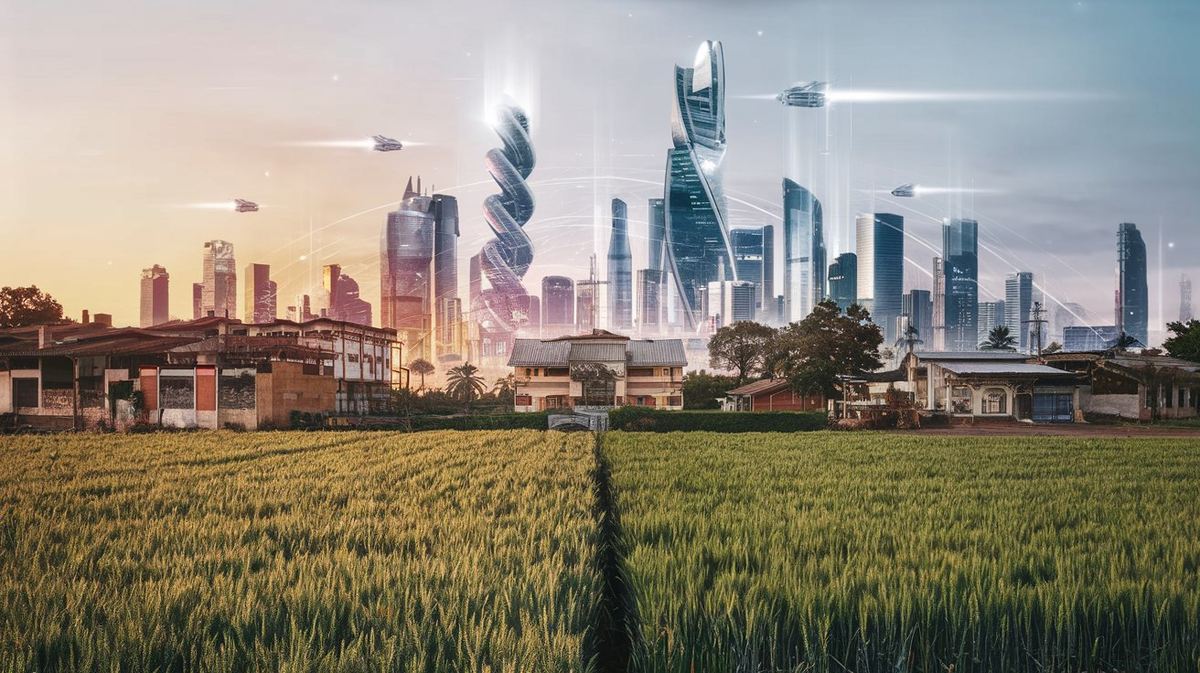Table of Contents
The integration of AI into urban planning presents both exciting opportunities and significant challenges. As AI reshapes city landscapes, its ethical and environmental impacts must be considered to ensure that technological progress doesn't come at the expense of ethical integrity or sustainability. Balancing these elements is crucial for creating urban environments that are not only innovative but also fair and sustainable. By focusing on the intersection of AI, ethics, and sustainable development, we can shape cities that cater to the needs of today's inhabitants while respecting the rights of future generations. This post explores how we can strike that essential balance.
The Role of AI in Urban Planning
Artificial Intelligence (AI) is changing how cities are designed and managed, pushing urban planning into a new era. Its potential lies in its ability to process vast amounts of information quickly, offering insights that were previously out of reach. By transforming raw data into actionable strategies, AI promises more efficient, sustainable, and liveable urban environments. But how does it all come together? Let's explore some key aspects.
Data-Driven Decision Making
AI thrives on big data. In urban planning, this translates to a goldmine of possibilities. By collecting and analysing data from various sources like sensors, social media, and surveys, AI helps planners make smarter decisions.
- Predictive Analytics: AI uses predictive analytics to foresee urban growth patterns. For example, it can predict traffic congestion by analysing current trends, allowing city planners to address potential problems before they arise. It's like having a crystal ball but one grounded in reality.
- Informed Strategies: With data-driven insights, city planners can better understand the impact of infrastructure projects. Imagine knowing which areas will benefit most from new roads or green spaces. This precision enables more targeted and effective urban development.
AI turns the data deluge into a powerful tool for crafting cities that are prepared for the future. So, how do we translate this data into tangible improvements in urban setups?
Smart Infrastructure Development
AI's impact goes beyond statistics—it shapes the physical infrastructure of cities too. The vision of smart cities hinges on AI's ability to integrate technology with urban systems, leading to a more efficient and sustainable environment.
- Traffic Management Systems: AI-driven traffic systems can adjust traffic lights in real-time to reduce congestion and emissions. It’s like having a digital traffic officer that keeps everything moving smoothly, ensuring everyone gets to their destination faster.
- Energy-Efficient Buildings: With AI, buildings can become more energy-efficient. Smart buildings use AI to monitor energy usage and optimise it based on current demand. This not only saves money but also reduces carbon footprints, making cities greener and more sustainable.
AI powers the next generation of urban infrastructure. By weaving technology into the fabric of our cities, we can tackle everyday challenges with innovative solutions. As we witness these transformations, one question remains: Are we ready to embrace the full potential of AI in urban planning?
Sustainable Development Goals and AI
The United Nations Sustainable Development Goals (SDGs) aim to create a better and more sustainable future by addressing global challenges like poverty, inequality, and climate change. In urban planning, AI stands as a powerful tool to advance these goals. How can AI contribute to building sustainable cities? Let's explore two key areas: enhancing urban resilience and optimising resource efficiency.
Enhancing Urban Resilience
AI can transform how cities tackle climate change and adapt to new challenges. Imagine a city as a complex puzzle, where each piece must fit together perfectly. AI helps piece together this puzzle by analysing vast amounts of data, predicting climate patterns, and identifying areas at risk.
- Predictive Analytics: AI can forecast weather events, like storms or floods, allowing cities to prepare in advance. AI-driven models can simulate climate scenarios, helping planners create strategies to mitigate risks.
- Smart Infrastructure: With AI, urban planners can design and manage infrastructure that adapts to the changing climate. For instance, AI can optimise drainage systems to handle increased rainfall, reducing flood risks.
- Emergency Response: AI enhances emergency services by providing real-time data on areas affected by natural disasters. This enables quicker response times, saving lives and resources.
Think of AI as a city's guardian angel, constantly watching and learning to protect its inhabitants from environmental threats.
Resource Efficiency and Waste Reduction
In the quest for sustainable cities, efficient use of resources is crucial. AI holds the key to smarter cities where waste is minimised, and resources are used wisely.
- Smart Energy Grids: AI helps manage energy consumption, ensuring that power is distributed efficiently. It can predict energy demand and adjust supply accordingly, reducing wastage.
- Waste Management: AI can sort and recycle waste more effectively than traditional methods. By identifying patterns in waste production, it can suggest measures to reduce waste at the source.
- Water Conservation: Smart water management systems powered by AI can monitor usage and detect leaks, conserving water and ensuring sustainable supply.
By integrating AI technologies, urban planners can not only meet but exceed the targets set by the SDGs (sustainable development goals), paving the way for cities that are not only resilient and efficient but also sustainable and healthy for future generations.
Case Studies of AI in Urban Planning
Urban areas around the globe are embracing artificial intelligence to optimise resources and enhance the quality of life for their residents. By examining specific examples, we can grasp how AI-driven strategies are making cities smarter and more sustainable. Let's explore the efforts in Barcelona and Singapore, two trailblazers in urban innovation.
- Barcelona's Smart City Initiative
Barcelona is a pioneer in smart city initiatives, integrating AI to tackle urban mobility and energy efficiency. The city uses AI to manage traffic, reduce pollution, and improve public transport. With sensors placed throughout the city, real-time data is collected to enhance the efficiency of bus networks and reduce congestion.
Energy management is another key focus in Barcelona. Smart meters and AI algorithms optimise energy usage, ensuring that buildings only use what they need. By doing so, the city has been able to significantly cut down on energy waste. This not only saves money but also reduces the city's carbon footprint, reinforcing its commitment to sustainability.
The impact of these AI-driven efforts is profound:
- Improved public transit: More efficient routes and schedules.
- Reduced emissions: Less congestion leads to cleaner air.
- Energy savings: Buildings consume less power.
Barcelona's approach highlights how AI can turn cities into more efficient and eco-friendly living spaces, serving as a model for others.
- Singapore's AI-Powered Urban Solutions
In Singapore, AI is at the heart of urban planning. Known for its meticulous city design, Singapore utilises AI to revolutionise urban solutions. The city-state has implemented an intelligent transport system equipped with AI to predict congestion and adjust traffic signals accordingly. This approach is akin to having a responsive map that constantly adapts, ensuring seamless travel across the city.
But Singapore's ambitions don't stop there. The city is also a leader in green building initiatives, using AI to design structures that are both eco-friendly and efficient. By analysing data on weather patterns and energy consumption, AI helps architects design buildings that maximise natural resources. It's like having a digital architect that never sleeps, always calculating the best way to utilise space and light.
Key achievements from Singapore's AI ventures include:
- Streamlined traffic flow: Less time spent in traffic jams.
- Innovative building designs: Modern structures that harmonise with nature.
- Enhanced resource management: Better use of water and energy.
Singapore's strategic use of AI propels it forward in sustainable development, offering a blueprint for cities eyeing similar transformations.
These case studies underline the transformative power of AI in urban planning, illustrating how cities can become more liveable and future-ready through intelligent technology.
Striking a Balance: AI, Ethics, and Sustainability
In the rapidly changing landscape of urban planning, AI presents a powerful tool that can help shape our cities. However, as we harness its potential, ethical challenges and sustainability must not be sidelined. Imagine balancing a set of scales with AI innovations on one side and sustainability principles on the other. The goal is equilibrium, where progress does not outweigh our responsibility to ethics and the environment. Let's explore some strategies to achieve this balance.
Participatory Urban Planning
Engaging local residents ensures that the AI solutions implemented reflect the distinct needs and values of the community. This approach not only encourages ownership and accountability but also ensures that decisions are rooted in real-world concerns.
- Empowerment: By actively involving citizens in decision-making, you empower them to influence changes in their own environment.
- Transparency: Open communication about AI processes builds trust and allows for input into the ethical considerations of these technologies.
- Inclusivity: Diverse voices lead to more comprehensive solutions, helping align urban planning with both ethical standards and sustainability goals.
This participatory method ensures that AI in urban planning serves the people, rather than sidelining them.
Regulatory Frameworks for AI in Urban Planning
Think of regulatory frameworks as the guardrails on a winding mountain road. They don't hinder the journey but ensure it's safe. Responsible AI use requires clear guidelines, much like those guardrails, to steer innovations in the right direction.
- Accountability: Establish legal responsibilities for AI's use and impact, ensuring firms and planners are held accountable for ethical breaches.
- Sustainability Standards: Regulations should mandate sustainable practices, such as reducing carbon footprints or enhancing green spaces.
- Privacy Protection: Safeguard personal data collected during urban projects to prevent misuse and ensure public trust.
- Adaptive Policies: As AI technology evolves, so must our regulations. Regular updates and reviews of frameworks will keep them relevant and robust.
By setting these guidelines, cities can responsibly harness AI's power, ensuring that both innovation and ethical considerations travel hand in hand.
Striking this balance isn't just about managing technology; it's about shaping futures. By combining participatory approaches and sound regulations, urban planning can responsibly advance with AI, holding firm to ethical standards and sustainability commitments.
Conclusion
Balancing AI innovation with ethical concerns and sustainability is critical for the future of urban planning. As cities evolve, it is essential to integrate technology that enhances quality of life but does not compromise ethical standards or sustainability goals.
Urban planners and policymakers must prioritise transparency and responsibility. This ensures AI advances are harnessed for the greater good. Sustainable development must be at the forefront to ensure cities remain liveable for future generations.
By embracing these principles, we can craft cities that reflect both human and environmental needs. Let's take an active role in shaping urban landscapes that are not only technologically advanced but also ethically sound and sustainable.


